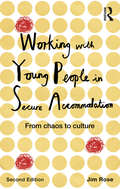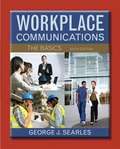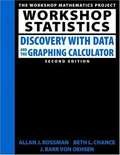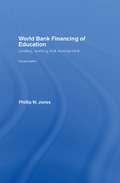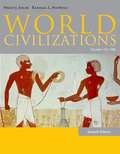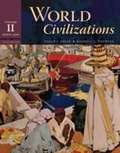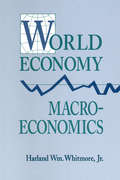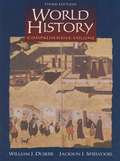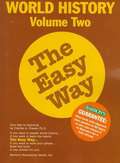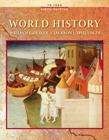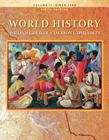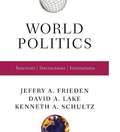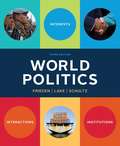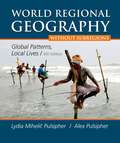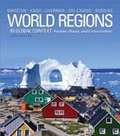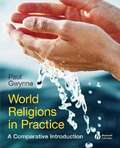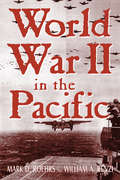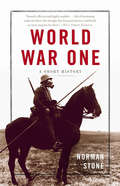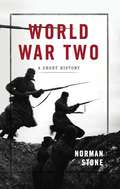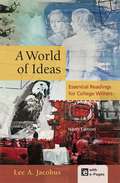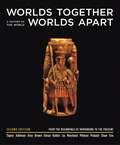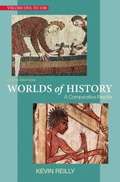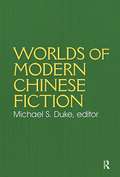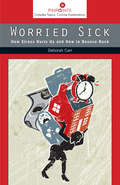- Table View
- List View
Working with Young People in Secure Accommodation: From chaos to culture
by Jim RoseThe detention of children and young people as a response to delinquent and antisocial behaviour remains a topical and controversial issue. In this new edition of Working with Young People in Secure Accommodation, Jim Rose provides an historical perspective on the topic of young people in custody and discusses the changes that have taken place in youth justice and the secure estate over recent years. Rose introduces new material and has updated the original content in order to reflect changes in policy and practice. New areas covered include a consideration of the issues arising for children and families who are detained while issues of immigration and removal are being determined and the detention of children in police custody. Using a framework of ideas and theories to support staff thinking, the central chapters explore in detail the dynamics that emerge when the daily work of staff requires them to engage with vulnerable young people in the intense conditions of a locked environment. The relationships between staff and young people are shown as critical for the achievement of positive outcomes. Taking a unique look at the issue of detention and its impact on young people, this highly topical book will be invaluable reading for practitioners, academics, policy makers and senior managers as well as students of social work, youth justice and education.
Workplace Communications: The Basics
by George J. SearlesWorkplace Communications is the first brief, less theory-intensive text that focuses on the fundamentals of workplace communication specifically intended for applied writing courses in community colleges and similar settings.
Workshop Statistics: Discovery with Data and the Graphing Calculator 2nd Edition
by Allan J. Rossman Beth L. Chance J. Barr von OehsenWorkshop Statistics emphasizes doing statistics as a way of learning statistics concepts and techniques. It assumes the use of the TI-83 graphing calculator. The "workshop approach" builds upon analysis of genuine data and provides practical experience. Unique in its format, an extensive series of over 90 practical activities and exercises leads students to discover statistical concepts, explore statistical principles, and apply statistical techniques. The book is widely praised as being one of the most innovative introductory texts for learning statistics.
World Bank Financing of Education: Lending, Learning and Development
by Phillip W. JonesBased on detailed analysis of thousands of confidential World Bank documents, this book demonstrates that the World Bank lies at the centre of the major changes in global education of our time. It outlines the evolution of World Bank lending policies in education, and assesses the policy impact of the Bank's educational projects, looking at how it has: shaped the economic and social policies of many governments, including policies that affect education been an influential proponent of the rapid expansion of formal education systems around the world, financing much of that expansion been instrumental in forging those policies that see education as a precursor to modernisation served as a major purveyor of Western ideas about how education and the economy are, or should be, related. Following on from the success of the first edition, this revised edition covers topical issues of globalisation and looks into the political debate concerning aid to developing countries. It will be of enormous value to those studying, or working in, educational policy in developing countries, international organisations and financial institutions, and aid agencies.
World Civilizations, Volume I: To 1700, Seventh Edition
by Randall L. Pouwels Philip J. AdlerWorld Civilizations, Volume I: To 1700, Seventh Edition, offers broad-based coverage of the world's major civilizations, in a brief-chapter format that presents information in manageable segments. The focused treatment of topics throughout history covers every major epoch and follows general patterns and processes, while illuminating history through specific examples and a particular emphasis on social and cultural topics.
World Civilizations, Volume II: Since 1500
by Randall L. Pouwels Philip J. AdlerShort chapters, great stories, and tons of study tools! Adler and Pouwels's WORLD CIVILIZATIONS is a vibrant introduction to world history structured to meet the demands of your study schedule. It's clearly written, packed with charts and illustrations, and loaded with review features so you'll be up to date in class and ready for the test. And, because WORLD CIVILIZATIONS offers extensive coverage of Asia, Africa, and the Middle East, you'll have timely historical insights into the issues that make today's news. Get WORLD CIVILIZATIONS and discover how having all the information you need to know for the test really does equal a better grade.
World Cultures and Geography
by Michael W. Smith David W. Moore Andrew J. Milson Peggy Altoff Mark H. Bockenhauer Janet SmithSocial Studies Textbook
World Economy Macroeconomics
by Harland William WhitmoreThis text develops a complex open economy macro-model of the world economy that synthesizes the new Keynesian and new classical approaches to constructing aggregate models. It extends the two approaches by offering a more general international and intertemporal transmission mechanism.
World History (Comprehensive Volume): 3rd Edition
by William J. Duiker Jackson J. SpielvogelThis comprehensive introduction to world civilizations covers individual civilizations such as China, India, and Europe, and provides points of comparison between and among these civilizations. It provides breadth and accessibility and contains a wealth of primary source documents, beautiful 4-color maps, and many useful supplements.
World History The Easy Way Volume Two: AD 1500 to the Present
by Charles A. FrazeeVolume II opens with major world events between 1500 and 1789, and considers the development of shipbuilding that sent European explorers around the world. Following topics include the Ottoman Empire, Mughal India, Manchu China, Spanish conquests in the Americas, European world colonialism, the French Revolution, Napoleonic Europe, British imperial expansion, the revolutions in the Americas, the United States and Canada as world powers, World War I and II, postwar Europe, the end of European colonialism, the Cold War, modern China, and events affecting Pacific nations.
World History to 1500 Sixth Edition
by William J. Duiker Jackson J. SpielvogelWORLD HISTORY textbook
World History, Volume II: Since 1500, Sixth Edition
by William J. Duiker Jackson J. SpielvogelThe book is a useful instrument for introducing students to world history. In this sixth edition, a number of new illustrations and maps have been added, and the bibliographies have been reorganized by topic and revised. The chronologies and maps have been fine-tuned to help the reader locate in time and space the multitude of individuals and place names that appear in the book. To keep up with the ever-growing body of historical scholarship, new or revised material has been added throughout the book on many topics.
World Politics
by Jeffry A. Frieden David A. Lake Kenneth A. SchultzWhy are there wars? Why do countries have a hard time cooperating to prevent genocides or global environmental problems? Why are some countries rich while others are poor? Organized around the puzzles that draw scholars and students alike to the study of world politics, this book gives students the tools they need to think analytically about compelling questions like these. World Politics introduces a contemporary analytical framework based on interests, interactions, and institutions. Drawing extensively on recent research, the authors use this flexible framework throughout the text to get students thinking like political scientists as they explore the major topics in international relations.
World Politics: Interest, Interactions, Institutions
by Jeffry A. Frieden David A. Lake Kenneth A. SchultzWhy are there wars? Why do countries struggle to cooperate to prevent genocides or to protect the environment? Why are some countries rich while others are poor? Organized around the puzzles that draw scholars and students alike to the study of international relations, World Politics gives students the tools they need to think analytically about the field's most compelling questions.
World Regional Geography: Global Patterns, Local Lives (Without Subregions) (Sixth Edition)
by Lydia Mihelic Pulsipher Alex A. Pulsipher Conrad Mac" GoodwinThe main goal of this book is to make global patterns of trade and consumption meaningful for students by showing how these patterns affect not only world regions but also ordinary people at the local level.
World Regions in Global Context: Peoples, Places, and Environments (5th Edition)
by Sallie A. Marston Paul L. Knox Diana M. Liverman Vincent J. Del Casino Paul F. RobbinsThe author provides a framework for understanding the global connections that affect the dynamic and complex relationships between people and the worlds they inhabit.
World Religions In Practice: A Comparative Introduction
by Paul GwynneA major new textbook exploring the world's great religions through their customs, rituals and everyday practices by focusing on this 'lived experience' it goes beyond many traditional introductions to religious studies. Adopts a directly comparative approach to develop a greater understanding of the nature of religion. Each chapter engages with an individual theme, such as birth, death, food, pilgrimage and ethics, to illustrate how religious practices are expressed. Broadens students' understanding by offering an impartial discussion of the similarities and differences between each religion.
World War II in the Pacific: History Of World War Ii In The Pacific
by William A. Renzi Mark D. RoehrsWorld War II laid the groundwork for much of the international system that exists today, especially in the Pacific Rim. This brief but comprehensive survey of the War in the Pacific incorporates both United States and Japanese perspectives, providing a global approach to the Asian theater of the conflict. Drawing on decades of new scholarship and written in an engaging, narrative style, this book traces United States-Japanese relations from the late nineteenth century to the war's end in 1945. It covers every aspect of the war, and gives special attention to ongoing historical debates over key issues. The book also provides new details of many facets of the conflict, including expansionism during the 1930s, events and policies leading up to the war, the importance of air power and ground warfare, military planning and strategic goals, the internment of Japanese-Americans in the U.S., Allied plans and disputes over Russian participation, the decision to drop the atomic bomb, and conditions for surrender.
World War One $ A Short History: A Short History
by Norman StoneThe First World War was the overwhelming disaster from which everything else in the twentieth century stemmed. Fourteen million combatants died, four empires were destroyed, and even the victors’ empires were fatally damaged. World War I took humanity from the nineteenth century forcibly into the twentieth-and then, at Versailles, cast Europe on the path to World War II as well. In World War One, Norman Stone, one of the world’s greatest historians, has achieved the almost impossible task of writing a terse and witty short history of the war. A captivating, brisk narrative, World War One is Stone’s masterful effort to make sense of one of the twentieth century’s pivotal conflicts.
World War Two: A Short History
by Norman StoneAfter the Great War, the United States and the nations of Europe longed for a lasting peace. As far as they were concerned, they had just experienced OC the war to end all wars. OCO Over 15 million lay dead, and much of Europe had been reduced to rubble. The possibility of another such conflict was practically unthinkable. And yet within two decades of the signing of the Versailles Treaty, war broke out once again, on such a cataclysmic scale that it would forever transform international geopolitics. In "World War Two," Norman StoneOCoone of the greatest living historians of the twentieth centuryOCoprovides an unprecedentedly concise, utterly authoritative account of the deadliest war of human history. Over 60 million people perished in World War Two, and the story of how the conflict roared to life from the ashes of the Great War is shocking, tragic, and also completely preventable in hindsight. The peace that Europe so craved after World War I hinged on European stabilityOCobut by demanding a massive indemnity from Germany in order to keep it from rearming, the Allies prevented Germany from recovering from the trauma of the Great War. The results, as Stone shows, were disastrous. Riding a tide of popular desperation and resentment, Adolf Hitler soared to power in Germany, and promptly made good on his promises to return the country to its former strength. He reinvigorated the German economy by rearming at a breakneck pace, then muscled his way into neighboring countries under a variety of pretenses, all while intensifying his campaign of anti-Semitic terror and forming a fascist bloc with the totalitarian regimes in Japan and Italy. His gamble was that the Allies, still shaken from the previous war, would not attempt to stop himOCoand for a time, he was right. a Britain and FranceOCOs eventual decision to declare war on Germany following the invasion of Poland in 1939 was utterly irrational, argues StoneOCobut then again, Hitler had driven the world insane. He had bullied all of Europe into giving him his way, and in doing so he had backed the victors of the Great War into a corner. Driven as much by a sense of outrage as anything else, the British leapt into the conflict; the French, fearing for their security, joined in. In time, and for their own unique reasons, the Americans and Soviets would enter the fray on the side of the Allies, as well. And so the conflagration spread across the globe, fanned by political and racial ideologies even more poisonous, and weaponry even more destructive, than those that had ravaged Europe in the previous war. Stone leads his reader through the inexorable escalation, savage climax, and mournful denouement of this sprawling conflict, providing along the way encapsulated accounts of the crucial battles of the war, from El Alamein, Stalingrad, and Midway to Anzio, Saipan, and Normandy. By the time World War Two had finally burned itself out in the capitals of Germany and Japan, the victors were already beginning to feel the chill of the oncoming Cold WarOCoa new sort of conflict, and one defined by the hitherto unseen devastation the globe had just experienced. With astonishing aplomb, Norman Stone traces the causes, course, and conclusion of this epic war. A stunning achievement, "World War Two" is a work of history of which only Norman Stone is capable. Brisk yet profound, pithy but endlessly informative, it is an invaluable contribution to our understanding of the twentieth century and its most defining conflict. "
World of Ideas: Essential Readings for College Writers (9th Edition)
by Lee A. JacobusThe first and bestselling reader of its kind, A World of Ideas introduces students to great thinkers whose ideas have shaped civilizations throughout history. When students hear names like Aristotle, Martin Luther King, Jr., or Sigmund Freud, they recognize the author as important — and they rise to the challenge of engaging with the text and evaluating it critically. No other composition reader offers a comparable collection of essential readings along with the supportive apparatus students need to understand, analyze, and respond to them.
Worlds Together, Worlds Apart: A History Of The World From The Beginnings Of Humankind To The Present
by Peter Brown Stephen Kotkin Gyan Prakash Robert Tignor Jeremy Adelman Stephen Aron Benjamin Elman Xinru Liu Suzanne Marchand Holly Pittman Brent Shaw Michael TsinIn this second edition, the book's non-Eurocentric approach continues with expansions of the original eleven world history "turning point" stories from the modern period to include ten more "turning point" stories from the earlier periods of world history. From the history of the world's first cities built on the great rivers of Afro-Eurasia, to the formation of the Silk Road, to the rise of nation-states, and the story of modern globalization, Worlds Together, Worlds Apart provides students with the stories that changed history and enables them to make the connections they need in order to better understand how the world came to be what it is today.
Worlds of History to 1550
by Kevin ReillyAssembled by award-winning community college teacher and distinguished world historian Kevin Reilly, the documents in the best-selling "Worlds of History" bring history alive for students. Students read voices from the distant and more recent past that address topics and issues -- like patriarchy, love and marriage, and imperialism -- of enduring interest and relevance. Ranging widely across regions and cultures, each chapter takes up a major theme and asks students to examine it in the context of two or more cultures, encouraging them to make cross-cultural connections and comparisons. The flexible comparative and thematic framework easily accommodates the variety of approaches instructors bring to teaching world history while supporting the general goal of cultivating critical thinking skills.
Worlds of Modern Chinese Fiction: Short Stories and Novellas from the People's Republic, Taiwan and Hong Kong
by Michael S. DukeThis book's pluralistic, non-dogmatic, and committed investigation of the values of ecological sustainability, economic justice, and human dignity provides balanced analysis of environmental problems and their potential solutions.
Worried Sick: How Stress Hurts Us and How to Bounce Back
by Deborah CarrComments like "I'm worried sick" convey the conventional wisdom that being "stressed out" will harm our health. Thousands of academic studies reveal that stressful life events (like a job loss), ongoing strains (like burdensome caregiving duties), and even daily hassles (like traffic jams on the commute to work) affect every aspect of our physical and emotional well-being. Cutting through a sea of scientific research and theories, Worried Sick answers many questions about how stress gets under our skin, makes us sick, and how and why people cope with stress differently. Included are several standard stress and coping checklists, allowing readers to gauge their own stress levels.We have all experienced stressful times--maybe a major work deadline or relocating cross-country for a new job--when we came out unscathed, feeling not only emotionally and physically healthy, but better than we did prior to the crisis. Why do some people withstand adversity without a scratch, while others fall ill or become emotionally despondent when faced with even a seemingly minor hassle? Without oversimplifying the discussion, Deborah Carr succinctly provides readers with key themes and contemporary research on the concept of stress. Understanding individuals' own sources of strength and vulnerability is an important step toward developing personal strategies to minimize stress and its unhealthy consequences. Yet Carr also challenges the notion that merely reducing stress in our lives will help us to stay healthy. Many of the stressors that we face in everyday life are not our problems alone; rather, they are symptoms of much larger, sweeping problems in contemporary U.S. society.To readers interested in the broad range of chronic, acute, and daily life stressors facing Americans in the twenty-first century, as well as those with interest in the many ways that our physical and emotional health is shaped by our experiences, this brief book will be an immediate and quick look at these significant issues.View a three minute video of Deborah Carr speaking about Worried Sick.
